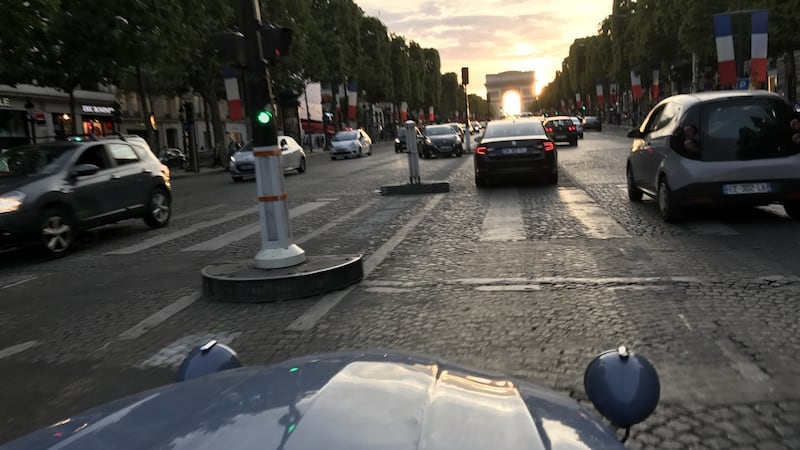As we turned onto the Champs Elysee, a little bit of Parisian magic happened. The setting sun, which had been slowly baking the city in near-30 degree heat all day, slipped behind the stone bulk of the Arc De Triomphe, and shone perfectly, symmetrically, through Napoleon's victory arch. Its yellow hues lent a sepia tint to the scene, locking this perfect moment in a capsule apparently sealed in the 1947 of the Citroen 2CV'd debut. Not the grim greys of black and white, but an image with warmer colours.
It could have been a movie set, but actually, this was just a normal Thursday in Paris, and we were taking a private tour of the city with the wonderful Geraldine, our guide for the evening. A former resident of Toulouse, she has given up a big house in the country to come and live in a tiny flat in the city, and give tourists a little taste of French motoring in an old Citroen. Why? "Because it's Paris…"
Geraldine is a driver for the 2CV Paris Tour and for a mere €70, you and three others can have a private tour of the City Of Lights in a thirty-year-old 2CV, travelling as far and as wide as its 435cc, 30hp engine will carry you.


Geraldine, quite aside from being charming and friendly, is also capable of guiding the quirky Citroen through Paris traffic with the aplomb of Alain Prost. In spite of the added weight of a chunky Irish motoring journalist, she's able to work that tiny two-cylinder air-cooled engine and its awkward-as-De-Gaulle-in-a-bad-mood gearshift like a pro.

Marauding Renault Talisman taxis and tourists in rented Dacias cause her no fears and even the dreaded no-rules roundabout at the Arc is despatched without incident, rancour, or panel damage. Frankly, Geraldine makes most modern racing drivers look pretty lacking in courage. And I bet that they can't give you a running commentary on the history of the Palais Royal as they go.
The 2CV itself is of course the big draw here. Small and apparently fragile it may be, and it’s definitely not quick, but it stands up surprisingly well to modern-day traffic conditions. Aside from lights that apparently don’t and brakes that possibly can’t, it whirrs and putters along happily, with exceptional comfort. The hammock-style seats help, of course, but the real magic here is in the suspension. Designed to be soft, springy, and long of travel, the 2CV’s chassis glides magically over tarmac scars and awkward cobbles. You see the obstacle approaching, you hear the entire body rattle and clatter, but the impact is soothed away in a manner that no modern 19-inch-rim-with-low-profiles could understand nor replicate. It’s beyond charming; it’s profound.
Tin snail
Profound because there is more significance to the 2CV than being a mere personalised tour bus. For much of Citroen’s history, the company seemed to be trying to get away from the ‘Tin Snail’ and its lowly class status, much as Volkswagen had to eventually escape the legacy of the original Beetle. Now though, there seems to be more enthusiasm amongst Citroen to engage with the spirit of the 2CV.
Speaking to Management Today, Citroen's current Chief Executive, Linda Jackson, seemed to tilt a little in the direction of the 2CV's timeless appeal when she said that "the car industry has had a very macho image in the past, and it is still quite blokey. That needs to change. Women are the decision makers when it comes to buying many cars, and at least 50 per cent of the cars we sell - more for some models - are bought by women."
Well, there’s little that’s macho about the 2CV, but much that is relevant. The original Autocar road test of 1948 elicited the sniffy comment that the car must have been “the work of a designer who has kissed the lash of austerity with almost masochistic fervour.” In this post-recession, post-Brexit world, that kind of austerity is familiar to too many of us, and it seems that Citroen has once again begun to tap into the appeal of the small, quirky car that’s cheap to buy and run. That, after all, is a perfect encapsulation of the current C4 Cactus, while the new drive within Citroen to engineer class-leading comfort into its cabins and chassis is without question a return to the legacy of the 2CV.
Such a move is surely the only way that the French car industry can finally put one over on its great rivals from Germany and Japan. For decades, it seemed that France had lost its way as a producer of cars, and that Citroen, Peugeot, and Renault were simply going to make cars that were the same as those made by Ford, VW, Opel and others, but perhaps not quite as good.
That has improved in recent years. Renault has found its styling feet again, after years of too many bland cars, but La Regie now needs to prove that it can do better on the engineering front than the too-timid Megane and Kadjar, and inject some of the inspiration and creativity that gave us the original 16 and Espace into its range. Peugeot has, too, come back from a long way away. After vehicular disasters such as the 307 and 207 got it off to a terrible start in the 2000s, Peugeot has recently shown that it can do good, even great, again with the likes of the 3008, 5008, and 308 GTI 270. Again, though, a little more innovation would be nice as would be a return to the quasi-premium days of the 505 and 406 Coupe.
Citroen does seem to be the best-placed French car maker right now though. The C4 Cactus proved that customers were responsive to more avant-garde design, while the C4 Picasso proves that MPVs don’t need to be un-stylish. The new C3 is the brand’s best car in years, and there is hope that the C5 Aircross might at last be a family MPV that majors on comfort rather than trying to be tiresomely sporty to drive. (The whole DS premium brand thing is a joke though and should just be stopped. Put the old C6 back into production instead - it still won’t sell, but at least it is unquestionably a great car.)
True successor
What hope a true successor to the 2CV, though? Perhaps better than you might think. When I asked design expert Stephen Bayley for his thoughts on the future of the car, his response name-checked both the 2CV and its more illustrious cousin: "I think that the next leap forward isn't going to be like the 1955 Citroen DS, it's going to be something astonishingly economical" Bayley told The Irish Times. "Someone, possibly even Citroen, is going to invent something like the original 1938 2CV, or even the 1980 Fiat Panda. Something extraordinarily simple, no electronic gadgets, a small oil burning engine, canvas seats. Something like that, in my view, would actually be tremendously exciting.It would get us back to that fundamentally gratifying thing of having a simple machine which is enjoyable to use."
As we glided, rattling, over the cobbles of Paris, with Gustav Eiffel’s iconic creation towering above the open roof, Bayley’s point rang astonishingly true. With a generation of car buyers potentially unable to afford a new car, thanks to The Terror of recession, perhaps it is time to return to the 2CV’s template.

Designed to be as economical as possible, and with its engineers reporting to a department that weighed every component, searching for possible weight savings, the 2CV is in so many ways a perfect template for the modern car. You could run one on a thimble of fuel, yet it was spacious, and practical. It was cheap to buy, but it was a convertible. Created by André Lefebvre, himself a racing driver, it rolled on its soft springs, but gripped the road with uncommon tenacity.
It's the sliver of opportunity for the French car industry, just as its German rival is reeling from scandal upon scandal. That Parisian mix of style (the architecture, the shops, the aesthetics), civility (the comfort of the George V hotel, those soft Citroen springs), frugality (the simple delight of some baguette, some cheese, and a little wine), and engineering prowess. Yes, I said that. Look at the Eiffel Tower, look at Concorde, look at the TGV and tell me the French can't engineer things as well as the Germans. Take all that, and mix it with the style and appeal of the 2CV and you could have the perfect modern car.
For me though, the 2CV is perfect enough as it is. Rattling along the longest, greatest street in Paris, with the setting sun turning the background to gold. Je m'en souviendrai pour toujours.
Many thanks to the 2CV Paris Tour (2cvparistour.com) and Irish Ferries for their help












